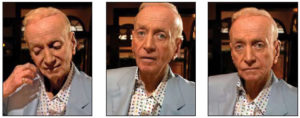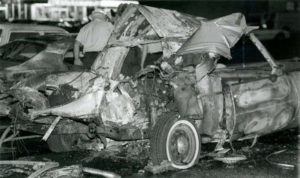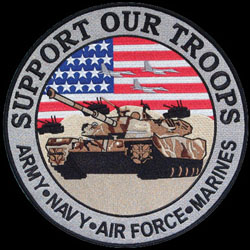Two people with knowledge of how the underworld works recently said they believe Kansas City mobsters were responsible for blowing up Frank “Lefty” Rosenthal’s car in Las Vegas during the early 1980s.
Those people are Gary Jenkins, a former Kansas City detective, and Las Vegas resident and former mobster Frank Cullotta.
First the backstory.
In a scary incident that literally shook parts of the city, Lefty Rosenthal, carrying an order of takeout ribs, was injured when his 1981 Cadillac Eldorado blew up outside the Tony Roma’s restaurant at 620 E. Sahara Ave. not far from the Las Vegas Strip.
A well-known figure around town, Rosenthal moved out of state not long after that but had been an oddsmaker operating the Stardust hotel-casino on the Strip for the Chicago Outfit. In that capacity, he oversaw the illegal skimming of casino profits for Midwestern mob bosses.
Even to this day, almost 35 years after the blast, no one has been able to identify who did it, though several theories exist.
One theory is that Rosenthal’s longtime friend, Tony “The Ant” Spilotro, was responsible.
Spilotro, a diminutive, brutal wiseguy sent by Chicago mob bosses in the 1970s to protect their interests in Southern Nevada, had been involved sexually with Rosenthal’s wife, a former Tropicana showgirl and chip hustler.
A fictionalized account of that combustible love triangle was at the center of the 1995 movie “Casino.”
I explored the Spilotro theory and other possible scenarios in an earlier “Mafia Chronicles” column here on the NewzBreaker site.
Not long after that column was posted, I interviewed Jenkins, a lawyer and former Kansas City Police Department intelligence detective, about the car bombing.
Jenkins operates the popular ganglandwire.com website and podcast.
In my video interview with him, conducted in mid-May, Jenkins expresses his belief that Kansas City mobsters, upset with Rosenthal for “drawing too much heat,” were responsible for the bombing.
 Mob bosses in Kansas City were exasperated by Rosenthal’s highly visible public posturing and out-in-the-open battles with gaming regulators.
Mob bosses in Kansas City were exasperated by Rosenthal’s highly visible public posturing and out-in-the-open battles with gaming regulators.
He was bad for business. All the attention he was getting jeopardized the lucrative cash deliveries coming to the Midwest from illegal skimming operations in Las Vegas.
Added to that, there was concern among mob heavies in Kansas City, recorded on secret law enforcement wiretaps, that Rosenthal was a government “snitch,” Jenkins says in my interview with him.
A recently published true crime book by Jenkins, “Leaving Vegas,” includes verbatim transcripts of the wiretaps in which Kansas City underworld figures voice their dismay with Rosenthal.
Something had to be done about him, and car bombings were a favorite tactic of the Kansas City mob in eliminating rivals, Jenkins says, adding that a car bombing had occurred in Kansas City at about the same time as the Rosenthal incident in Las Vegas.
For background on the Kansas City-Las Vegas mob connection, and to view a separate interview I conducted with Jenkins, go to my “Mafia Chronicles” column on the topic.
A second person with an insider’s perspective also believes the Kansas City mobsters “rigged” Rosenthal’s car to explode that October night in 1982.
That person is Frank Cullotta, who served as an underboss for Spilotro in Las Vegas.
Cullotta and Spilotro had been childhood friends in Chicago, but Cullotta later became a witness for the government, testifying against his pal after learning that a paranoid Spilotro planned to have him “whacked.”
Just this week in a podcast posted on the Gangland Wire site, Jenkins and Cullotta briefly discuss their shared view that Rosenthal was a government informant and that Kansas City mobsters were the ones responsible for the bomb.
Speculation that the Rosenthal bombing was tied to Kansas City mobsters is not entirely new.
In his 2013 autobiography “Being Oscar,” written with author and Philadelphia journalist George Anastasia, former Las Vegas Mayor Oscar Goodman says car bombings were something that happened more in Kansas City than Las Vegas.
“In Las Vegas,” Goodman writes, “the Chicago way of doing things — a .22 bullet to the head — was more common.”
Goodman adds he had heard that “some investigators believed the car bomb was because the guys in Kansas City thought Rosenthal was cooperating with the FBI.”
Before becoming mayor, Goodman was a criminal defense attorney who represented not only Rosenthal and Spilotro but also Kansas City mob boss Nick Civella.
As recently as two months ago, however, Goodman said during a panel discussion at The Mob Museum in Las Vegas that he doesn’t know who is responsible for the bomb blast targeting Rosenthal.
So while current speculation holds that Kansas City mobsters are responsible, the status of the case remains as it did in the ’80s — unresolved.
Other things from that period since have changed. Many of the major participants are dead, including the three at the heart of the disastrous love triangle, the two Rosenthals and Spilotro.
Even the old Tony Roma’s restaurant is different. The place closed in 2014, later reopening as a Hustler Hollywood adult store.
A video I shot of the vacant Tony Roma’s restaurant in 2015, before it was converted into a adult store last year, is on my YouTube channel.
Now, probably unbeknownst to many passing by on East Sahara, the site of that long-ago bombing is where customers who once could order ribs later could purchase, in what might seem like an ironic twist to those remembering that fateful mob romance gone bad, what a Hustler sign out front refers to as “erotica.”
Larry Henry’s YouTube channel includes videos he shot of mob sites in Las Vegas, the apartment building in Santa Monica, California, where Whitey Bulger was arrested, and the remote Arkansas airport where Barry Seal transported drugs into the U.S for the Medellin Cartel. Subscribe HERE.
[si-contact-form form=’2′]

 June 24th, 2017
June 24th, 2017  CEO
CEO 
 Posted in
Posted in  Tags:
Tags: 



